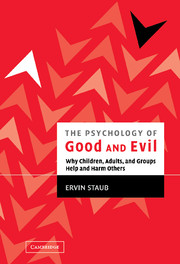Book contents
- Frontmatter
- Contents
- Preface
- Acknowledgments
- PART I INTRODUCTION AND CORE CONCEPTS
- PART II THE ROOTS OF HELPING OTHER PEOPLE IN NEED IN CONTRAST TO PASSIVITY
- PART III HOW CHILDREN BECOME CARING AND HELPFUL RATHER THAN HOSTILE AND AGGRESSIVE
- PART IV THE ORIGINS OF GENOCIDE, MASS KILLING, AND OTHER COLLECTIVE VIOLENCE
- 21 A Note on the Cultural–Societal Roots of Violence
- 22 The Psychology of Bystanders, Perpetrators, and Heroic Helpers
- 23 Steps Along a Continuum of Destruction: Perpetrators and Bystanders
- 24 The SS and the Psychology of Perpetrators: The Interweaving and Merging of Role and Person
- 25 The Origins of Genocide: Rwanda
- 26 Bystanders as Evil: The Example of Rwanda
- 27 Individual and Group Identities in Genocide and Mass Killing
- 28 Mass Murder: U.S. Involvement as Perpetrator, Passive Bystander, Helper
- 29 When Instigation Does Not Result in Mass Murder
- 30 Persian Gulf Conflict Was Reflection of Stormy Undercurrents in U.S. Psyche
- 31 Mob Violence: Cultural–Societal Sources, Instigators, Group Processes, and Participants
- 32 Understanding and Preventing Police Violence
- PART V THE AFTERMATH OF MASS VIOLENCE: TRAUMA, HEALING, PREVENTION, AND RECONCILIATION
- PART VI CREATING CARING, MORALLY INCLUSIVE, PEACEFUL SOCIETIES
- Appendix: What Are Your Values and Goals?
- Index
- References
26 - Bystanders as Evil: The Example of Rwanda
Published online by Cambridge University Press: 07 May 2010
- Frontmatter
- Contents
- Preface
- Acknowledgments
- PART I INTRODUCTION AND CORE CONCEPTS
- PART II THE ROOTS OF HELPING OTHER PEOPLE IN NEED IN CONTRAST TO PASSIVITY
- PART III HOW CHILDREN BECOME CARING AND HELPFUL RATHER THAN HOSTILE AND AGGRESSIVE
- PART IV THE ORIGINS OF GENOCIDE, MASS KILLING, AND OTHER COLLECTIVE VIOLENCE
- 21 A Note on the Cultural–Societal Roots of Violence
- 22 The Psychology of Bystanders, Perpetrators, and Heroic Helpers
- 23 Steps Along a Continuum of Destruction: Perpetrators and Bystanders
- 24 The SS and the Psychology of Perpetrators: The Interweaving and Merging of Role and Person
- 25 The Origins of Genocide: Rwanda
- 26 Bystanders as Evil: The Example of Rwanda
- 27 Individual and Group Identities in Genocide and Mass Killing
- 28 Mass Murder: U.S. Involvement as Perpetrator, Passive Bystander, Helper
- 29 When Instigation Does Not Result in Mass Murder
- 30 Persian Gulf Conflict Was Reflection of Stormy Undercurrents in U.S. Psyche
- 31 Mob Violence: Cultural–Societal Sources, Instigators, Group Processes, and Participants
- 32 Understanding and Preventing Police Violence
- PART V THE AFTERMATH OF MASS VIOLENCE: TRAUMA, HEALING, PREVENTION, AND RECONCILIATION
- PART VI CREATING CARING, MORALLY INCLUSIVE, PEACEFUL SOCIETIES
- Appendix: What Are Your Values and Goals?
- Index
- References
Summary
The passivity and/or complicity of “bystander nations” was especially horrifying in the case of Rwanda. It is important to examine it as a case study of what should not happen. In addition to considering perpetrators of great and “unjustified” violence as evil, should passivity that allows great harm to others ever be considered evil?
The circumstances bystanders face in a situation such as Rwanda are different from those of witnesses who see in front of them a person who is in great distress and needs help (des Forges, 1999). Even then, circumstances are usually ambiguous: There is pluralistic ignorance, diffusion of responsibility, and the diffidence of many people to step forward (Latané & Darley, 1970; Staub, 1974). However, circumstances preceding collective violence are often more ambiguous. Perpetrators usually claim self-defense or other good reasons for what they do. When there is mob violence against a victim group, which often is instigated by authorities, participants and the authorities usually claim that it was the spontaneous response of the population to threat, danger, and violent actions by others.
In this spirit, perhaps, France sent troops to help the Rwandan government in 1990, when a small rebel group that called itself the Rwandan Patriotic Front (RPF) entered the country from Uganda. This group consisted primarily of Tutsi refugees who had lived in Uganda since they escaped earlier waves of violence against Tutsis, beginning in 1959.
- Type
- Chapter
- Information
- The Psychology of Good and EvilWhy Children, Adults, and Groups Help and Harm Others, pp. 346 - 350Publisher: Cambridge University PressPrint publication year: 2003



